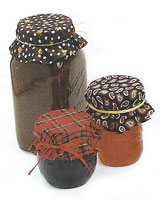|
|
Preserving
Food

A
careful selection of the food that
is to be preserved is the most important part of the whole
process. The flavor of the finished product also depends a
great deal on the condition of the food. So, whenever possible, any food that is to
be preserved should be perfectly
fresh. The sooner it is preserved after it has been gathered, the more
satisfactory will be the results.
Keep in mind that a succesful preserving depends entirely on
destroying harmful micro-organisms that are present in the food and
preventing those present in the air from entering the food.
NOTE: For all curing
always use pickling salt and
not table salt, as the latter contains starch to keep it dry
and this starch may cause the meat to spoil.
Pickling Salt or Dairy Salt is
fine-grained salt that has no additives and is generally used in brines
to pickle foods. Unlike table salt, the lack of additives will help
keep the pickling liquid from clouding.
If
you carefully
follow our preserving directions you will have delicious cured meat,
and well preserved fruits and vegetables.
Table of
Contents:
|
|
| Canning
Tips |
| Did you know that the
higher the altitude the lower the
degree of
heat required to boil water. Time-tables given in instructions for
canning are usually based upon the requirements of an altitude of
500 feet above sea level. Generally speaking, for every 4000-foot
increase in altitude it will be well to add twenty per cent to the
time required as given in recipes or time schedules for the canning
of all kinds of fruits, vegetables, greens and meats. |
|
| Never
use a Mason cap
twice unless the cover and collar are separate so that both can be
completely sterilized. |
|
| If
you are using the jars with a vacuum-seal which have a composition
attached to the tops, carefully examine this rubber
composition to see that it is perfect. This composition should go
entirely round the top and should not be cut or broken in any
place. If it is the top must be discarded for a perfect one. |
|
While
it is possible to safely preserve many kinds of foodstuffs, home
canning can expose consumers to botulism and other kinds of food
poisoning if done incorrectly. Because of the high risk of illness or
death associated with improper canning techniques, the United States
Department of Agriculture (USDA) considers it critical that consumers
who intend to can at home obtain proper and current information from a
reliable source. At the basis of these recommendations is the balance
between bringing the food to a high enough temperature for a long
enough time that spoilage and disease-producing microorganisms are
killed, while not heating the food so much that it loses nutritive
value or palatability.
|
|
|
|